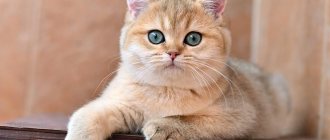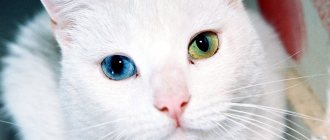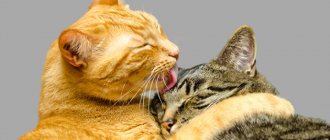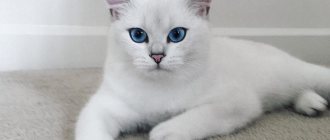Briefly about the breed
| Geography of origin | Thailand |
| WCF code | KOR |
| FIFe code | KOR |
| Coat type | shorthair |
| Dimensions | small or medium |
| Average weight | 2 - 4.5 kg |
| average life expectancy | 13-15 years old |
| Price | 25,000 rub. |
Advantages and disadvantages
affectionate
playful
smart
doesn't like to be alone
conflicts with other pets
Breed characteristics, character
Cats have a kind and friendly character and easily find a common language with their owners. The beast is distinguished by great devotion, which is expressed in the desire to be a participant in all household affairs.
Increased curiosity can make a cat want to go outside. For this reason, when opening the door to the apartment, it is better to be careful so that the mustachioed adventurer does not jump out into the entrance.
Another feature of the Korat is increased care for the offspring, which is manifested in both sexes. In other breeds, it is rare to find cats that pay attention to the younger generation.
Origin story
Images of the ancient Korat cat, also known as Shi-Sawat, appear in the book The Cat Book of Poems, which dates back to the Thai Ayudhya period (1350-1767). Shi-Sivat, as stated in an ancient source, brings good luck to a person.
In the history of Thailand, cats have never been sold, but a pair of Korats has always been considered the best gift. Depictions of cats in paintings from the 14th to 16th centuries are very similar to the breed as it is today, and all modern Korats have Thai ancestors in their pedigrees.
It is unknown when korat first came to the West. A cat that resembled this breed in type was exhibited at an exhibition in England in 1896, but whether it was really a representative of the breed or just Siamese blue cats is not known. It wasn't until 1959 that this cat arrived in the United States.
The breed received official recognition in 1966. The first federation to recognize Korat cats was the ACA, and a little later the breed was recognized by the CFA federation.
wikipedia
Breeding
Korats are not allowed to be bred with other breeds.
Only animals that meet all the requirements of the standard can participate in breeding. It is important that they are examined by a veterinarian before mating.
Be sure to read:
Toyger cat - a breed similar to toy tigers, description and character of a tiger cat
Carat cats are fully formed by three to four years of age, so early matings are not recommended. The break between them should be a year so that the animal’s body has time to recover.
First mating
A cat is ready for pregnancy at the age of about one and a half to two years. It is important to wait two or three heats before the first mating.
A course of antihelminthic medications and a thorough examination by a veterinarian are necessary before the cat meets its partner for the first time. Three months before mating, vaccinations must be done.
It is better to conduct the meeting in the territory of the male.
Korats are not allowed to be bred with other breeds
Pregnancy and childbirth
Korat kittens are gestated for an average of 65 days. Pregnancy and childbirth occur without complications, but it is better to be periodically examined by a veterinarian.
A cat of this breed is a very caring mother; during the first weeks of life she practically does not leave her offspring. Cats also participate in “upbringing” and protect the kittens.
Standard
Korats have a silver-blue coat and large green eyes - “sparkling like drops of dew on a lotus leaf.” They are considered one of the most beautiful cat species in Thailand. It is also known for its heart-shaped head, large ears and wary facial expression.
The breed standard is as follows:
- A kitten's eyes are blue at birth. As the cat matures, the pupils become amber, surrounded by a dark green “fringe.” By the time the animal is two to four years old, the eyes acquire the bright green color for which the Korat cat breed is famous;
- The ears of this breed are large, with rounded tips, set high on the head, which is why an “alarmed” expression freezes on the cat’s face. The hair on the outside of the ears is very short and dense;
- the hairs of the short coat are blue at the roots. Towards the end of the hair, the color smoothly turns into silver, which is why a halo effect is achieved. Unlike some cat breeds, the coat is silver-blue from birth, although Korat kittens may have dark markings on the coat until they are six months old;
- The color of the skin of the nose, mouth and paw pads of cats varies from dark blue to lavender.
Description and appearance
Males and Korat cats are medium-sized but muscular animals. The average cat weighs 4-5 kilograms, a cat weighs 2-3 kilograms.
The standard defines the following parameters:
- The head is shaped like a heart. The forehead is large, flat, and the lower jaw is well developed. The brow ridges form the upper part of the “heart”, the muzzle gradually tapers downwards.
- Nose with a pronounced stop.
- Bengal cat
Kurilian Bobtail
Chartreuse
Large eyes set wide apart. They give the muzzle a wary or surprised look. Acceptable iris colors: green, golden-green. Kittens are born with amber or yellow eyes, which change color by the age of two or four years.
- Large ears are set high. They are wide at the base and rounded at the tips. The hair on the outside of the ears is short, the inside is almost hairless.
- The tail is proportional to the body, tapering towards the tip.
- The body lines are smooth. The chest is wide, the back is smoothly curved.
- Strong limbs are proportional to the torso, the front ones are shorter than the rear ones. The feet are oval in shape, with five toes on the front and four on the back.
Visible tail breaks and more or less toes are not allowed.
Character
The Korat loves attention and considers himself an important person, whether he is surrounded by other cats, dogs or owners. If there are cats of other breeds living in the house, they are more likely to prefer each other’s company. Nevertheless, these animals become attached to their owners and get along well with children.
When an animal appears in the house, you should expect that the Korat cat will be closely interested in everything the owner is doing, from reading the newspaper to cooking. The pet will always be close to the person, since Korats are social animals and do not like to be alone for several hours. At the same time, Korat cats do not like loud noises or great excitement.
INTERESTING TO KNOW: Brazilian Shorthair is a strong breed
These animals are less talkative than their Siamese counterparts, but they definitely know how to communicate clearly with their owner using “body language.”
Korats are energetic, playful and very intelligent. When purchasing cats of this breed, you should be prepared for the fact that your pets will need food for thought. It is recommended to acquire special puzzle toys that will keep your cat occupied if its company is undesirable.
Nutrition
Most breeders recommend feeding Korats with premium food. Choose from lines for short-haired, active breeds.
If a natural diet is assumed, then 90% of it should consist of lean meat.
The diet includes:
- beef, veal;
- chicken or turkey meat;
- rabbit meat;
- lean pork;
- offal (liver, kidneys).
Three or four times a week the pet is given eggs, cottage cheese, milk or fermented milk products. Boiled or stewed vegetables and cereals are allowed once every seven days. They are given as an addition to meat. Fish and seafood are included in the diet three or four times a week.
An adult cat is fed two or three times a day. Kittens and pregnant or lactating cats require more frequent feeding up to four times a day.
In addition to the natural diet, the animal is given multivitamin complexes twice a year. Veterinarians recommend planting special grass for cats. It is especially relevant in the winter-spring period.
Health
Both purebred and mixed breed cats have a variety of health problems that may be genetic.
Expert opinion
Svetlana Ivancheva
Vet
Ask a Question
Korats are considered a fairly healthy breed with good immunity. However, these cats are prone to genetic neuromuscular degenerative disease and also have low levels of body fat, which can make them sensitive to anesthesia during surgery.
- GM1 and GM2 gangliosidosis (characterized by autosomal recessively inherited deficiency of the enzyme GM-b-galactosidase) occur when the animal's body lacks certain enzymes necessary for the normal functioning of the nervous system. This disease is rare, however, when purchasing a kitten, you should immediately test for the presence of gangliosidosis;
- Korats tend to have a low percentage of body fat, so veterinarians must take this into account when determining the type of anesthesia when performing any type of surgery on the animal.
With proper care, the pet's age can reach 20 years.
Health and life expectancy
On average, Korats live 15-17 years. Some pets lived up to twenty years.
Representatives of the breed must be protected from hypothermia and drafts. They are prone to colds.
Cats and cats often have food allergies. They are manifested by hair loss and redness of the skin. This feature complicates the selection of dry food.
Animals are predisposed to the following genetic diseases:
- gangliosidosis (retardation in physical development);
- atelosteogenesis (improper bone formation).
The first vaccinations are given to Korats at six months. Revaccination is carried out after 3-6 months.
If the animal is not planned to participate in breeding, it will be castrated. Cats are neutered or spayed at 8-10 months of age. It is better to do this before the first heat. Males are neutered before they reach one year of age. The optimal age is 7-10 months. If you monitor your pet’s diet and avoid overeating, obesity and related diseases will not overtake him.
Care and maintenance
Caring for Korats is not difficult, since these animals most often do not have significant congenital diseases and do not require scrupulous handling. The basic rules for keeping a pet are:
- cats have short and unpretentious hair, which, however, requires little care. Weekly brushing is enough to remove lost hairs and rare water treatments if the coat is heavily soiled;
- To prevent periodontal disease, Korats should brush their teeth. Daily oral hygiene is preferable; in extreme cases, the animal should brush its teeth weekly;
- Cats should have their nails trimmed once every two weeks;
- If any discharge appears in the corners of the animal’s eyes, they must be wiped with a soft, damp cloth. In this case, each eye should be treated with separate pieces of tissue to prevent the spread of infection;
- Your pet's ears should be checked weekly. If they look dirty, you should wipe them with a cotton swab or a soft, damp cloth soaked in a mixture of 50 percent apple cider vinegar and warm water. In this case, it is necessary to avoid the use of cotton swabs, which can damage the inside of the ear;
- Your pet's litter box should be kept clean. These cats are very attentive to their own hygiene and the hygiene of the surrounding area.
It is recommended to keep this breed indoors to protect the animal from diseases spread by other cats. Also, dog attacks and other dangers faced by cats allowed to roam. Cats that go outside run the risk of being stolen by someone because they are representatives of a beautiful and rare breed.
The pet will appreciate the attention of a child who will treat him with respect. With proper supervision and training, Korats can be companions for children.
Like many cats native to Southeast Asia, Korats prefer the company of other Korats when interacting with animals. They can get along with cats of other breeds and dogs, but in the case of these contacts they will try to take a leading position due to their temperament, which can lead to a conflict between the cat and another animal.
INTERESTING TO KNOW: Cheerful and affectionate exotic cat
However, these pets are social and enjoy company.
Care
Korats grow slowly and take up to 5 years to fully develop. Over time, their fur becomes silver and their eye color becomes bright green. Kittens may look homely, like the ugly duckling, but that shouldn't scare you. They will become prettier and become silver-gray lightning bolts.
Korat fur has no undercoat, lies close to the body and does not form tangles, so it requires minimal care. However, the grooming process itself is a pleasure for them, so don’t be too lazy to brush them once again.
The main disadvantage of this breed is its rarity. You can’t just find them, and if you manage to find a nursery, you’ll have to stand in a long line. After all, everyone wants a cat that brings good luck.
What to feed a Korat
The Korat generally does not have any gastrointestinal problems, so it does not require a special feeding schedule or special diet. These are energetic and active animals, so you should choose a high-calorie diet for them. When feeding Korat cats, preference should be given to natural feeding, but dry food is also suitable for the daily diet.
It is highly not recommended to feed your cat “from the table”, because the presence of a large amount of spices and salt in food can negatively affect the functioning of the digestive system in the future.
If your cat requires a diet due to illness or weight problems, you should consult a veterinarian for advice.
Character and behavior
These gentle creatures have an abundance of love, so they are generous in showing affection and care to their owner, whom they choose from the very first days in their new home. Moreover, they choose once and for all, giving him all the fervor of their heart. This love has no boundaries: only in the presence of the owner is the Korat happy and cheerful, only for him alone will he faithfully wait at the front door and only for him is he woken up in the morning by a ringing “meow!”
If your pace of life allows you to spend a lot of time at home, if you are not bothered by constant attention and a gray ball curling near your feet, this cat is made just for you. Otherwise, choose another breed.
Korats love to be the boss in the house, but since they bow to humans and obey them unquestioningly, other pets are targeted. Cats, especially weak ones, will definitely not have peace, and the Korat is not afraid of dogs (even big ones) and tries his best to let them understand who is boss in the house. Small rodents and birds are prey for cats, so try to protect them as much as possible from the toothy predator.
Korat understands immediately who little children are and why they should not be offended. Therefore, rest assured: he will not touch your little one, even if the latter swings a rattle at the cat or tries to put a doll’s cap on him. However, it is also not a cat’s style to tolerate obscenity for a long time. Seizing the moment, the Korat will simply run away and hide in a secluded corner.
These are sociable and sociable cats, so whether you like it or not, you will have to talk to them every day. Whether it lasts for a long time or not depends on you, but the Korat is ready to coo for hours. His vocal abilities are fully developed, so you will hear a diverse cacophony of sounds: from the most gentle purr to a real lion’s roar. However, the latter happens extremely rarely, and you still need to be able to bring the cat to the state of an angry “king of beasts” - they are so patient.
The love for games in Korat cats seems to be in their blood. So is curiosity. Snooping from room to room, opening and examining all the cabinets and boxes, poking your nose into all the bags and pots, and also stealing a small shiny thing and hiding it in your house or under the bed.
You, as a caring owner, need to make your home as safe as possible in advance: put strong screens on the windows, hide wires and sharp objects, put medicines and household chemicals away, raise poisonous plants higher.
You can find a Korat cat, but you will have to spend a lot of effort and money on it. This breed, despite its external beauty, stable psyche and good character, is practically not bred in Russia. And there is often deception on the part of sellers when they pass off a Russian Blue or a similar type as a Korat. The cost of a kitten for the “soul” ranges from $400 and above, show class - 2-3 times more expensive. You can try to order a Korat kitten through a Thai nursery or through intermediaries.
Price, where to buy, how to choose
The average price of a show-class Korat cat is 25,000 rubles. It is recommended to purchase an animal with a pedigree from a reliable breeder to avoid hereditary diseases and breed mixing.
Korat kittens.
When choosing a breeder, you should personally visit the house where the kittens are raised, meet the parents and observe the conditions in which the kittens are raised. It is necessary to ask the breeder about the prevalence of health problems in the pedigree and about testing for genetic diseases, not only in kittens, but also in adult cats.
There are no single-breed Korat nurseries in the CIS countries. You can only find a cat of this breed far abroad: in Thailand, Europe, the USA. For example, the website of a French nursery.
When contacting private resellers, you should be very careful not to run into a scammer.
Experts recommend an organization created to protect and popularize breeds - Cat Fanciers Association (CFA), where they will help you choose the nearest convenient nursery.
Korat cat: kitten price
Since you can only buy a Korat kitten abroad or, if you are lucky, from a rare breeder who transports Korats, you should understand that the price of a Korat, by definition, cannot be low. Price may vary depending on factors such as:
- Class;
- pedigree;
- delivery location, etc.
If you're lucky, you can buy a purebred kitten for a very reasonable price. But with the condition of his castration or sterilization, in order to avoid subsequent reproduction. You can also buy an aged Korat inexpensively, if this option is acceptable to you. In any case, breeders are people too and you can always agree on the price and other conditions for purchasing an animal. If we take the average value as a basis, then it is worth considering that although the price of kittens varies depending on the country, as a rule, in any case it does not fall below $500.
Considering the above, you should be wary of offers to buy a Korat kitten through a message board on the Internet, and even more so at the bird market.
Korat and Russian Blue cat breeds
The Korat and Russian Blue are similar in appearance, so when buying a kitten you should pay attention to its physique, so that an unscrupulous breeder does not sell the buyer a representative of the more common beard. Korats are denser and more muscular, and therefore weigh more than Russian Blues.
This is a Russian Blue breed.
This is a korat.
They are distinguished by a darker shade of their coat and do not have an undercoat, unlike Russian Blues.
Breeding and care
Korats have one similarity with ordinary mongrel cats - this is minimal care, which consists of the following points:
- Sometimes you need to comb your pet, since Korats have short hair and no undercoat, two to three times a month will be enough;
- You should trim your claws periodically, making sure to treat them with peroxide before doing so. To deprive yourself of this extra care and not to irritate your pet, it will be easier to purchase a scratching post;
- Every day you need to examine your pet's ears and eyes. There should be no accumulation of dirt in the ears; a damp cotton pad can be used for cleaning. To wash your eyes, use a cloth soaked in tea.
That's all about caring for Korat cats. Also, do not forget about proper nutrition. When using ready-made food, you need to spare no expense and buy expensive food; it won’t hurt your pocket too much, since the cat doesn’t eat that much, but the pet will receive all the beneficial substances for the body. When feeding naturally, you should give your pet lean meat, dairy products, herbs and vitamins.
Korats are naturally endowed with good health, but there are ailments that occur in some individuals. For example, Korats are prone to allergies and colds, but proper nutrition and timely vaccinations will help solve this problem.
As for breeding, everything is the same as with ordinary cats - the main thing is to find a worthy partner and ensure that the mating is successful. It is much more difficult to prove that a cat is indeed a Korat. Conditions for registering a pet as a purebred cat:
- There must be official documentation that the kitten or its parents were imported from Thailand;
- The color must be exclusively blue;
- Individuals for breeding must pass a DNA test;
- After the test, you need to put a chip on your pet or tattoo it;
- All vaccinations must be completed at a veterinary clinic.
If the cat meets all the points on the list, then it is a full-fledged Korat and receives the appropriate document.
Reviews of Korat cats
- Valeria.
Korats are amazing cats, I just adore them. I have one of these living with me. The only problems were with the selection of food, but now the diet has improved, we give Royal Canin food, but before that we had absolutely no idea what to do - the cat had an allergic reaction to all the food.
- Ksenia.
Korats are beautiful! We bought a cat a couple of months ago, I want to hug him all the time, my husband is already jealous of the cat, he says that if he doesn’t come home one day, I won’t even notice his absence. For cats, I buy almost all the lines of food presented, to choose from. I love him very much!
Feeding and health of Korat cats
The health and longevity of a cat depends on its nutrition, so it is necessary to follow the recommendations.
Natural food:
- lean meat;
- sea fish;
- fermented milk;
- porridge;
- offal.
Ready-made super-premium food is acceptable.
Forbidden:
- sweet, salty, smoked;
- legumes;
- pork meat;
- nuts;
- flour;
- food from the human table.
When choosing mixed feeding, you should never give your cat ready-made and natural food, or dry and wet food at the same time.
Korats have excellent health, however, during the breeding period, cases of gangliosidosis, as well as bone development disorders, were noted. A healthy cat can live twenty years.
Every day you need to set aside time for your pet, play with it, pet it and love it. In this case, the Korat will certainly respond with mutual affection and adoration, which means it will become a faithful and devoted friend to every member of the family.











